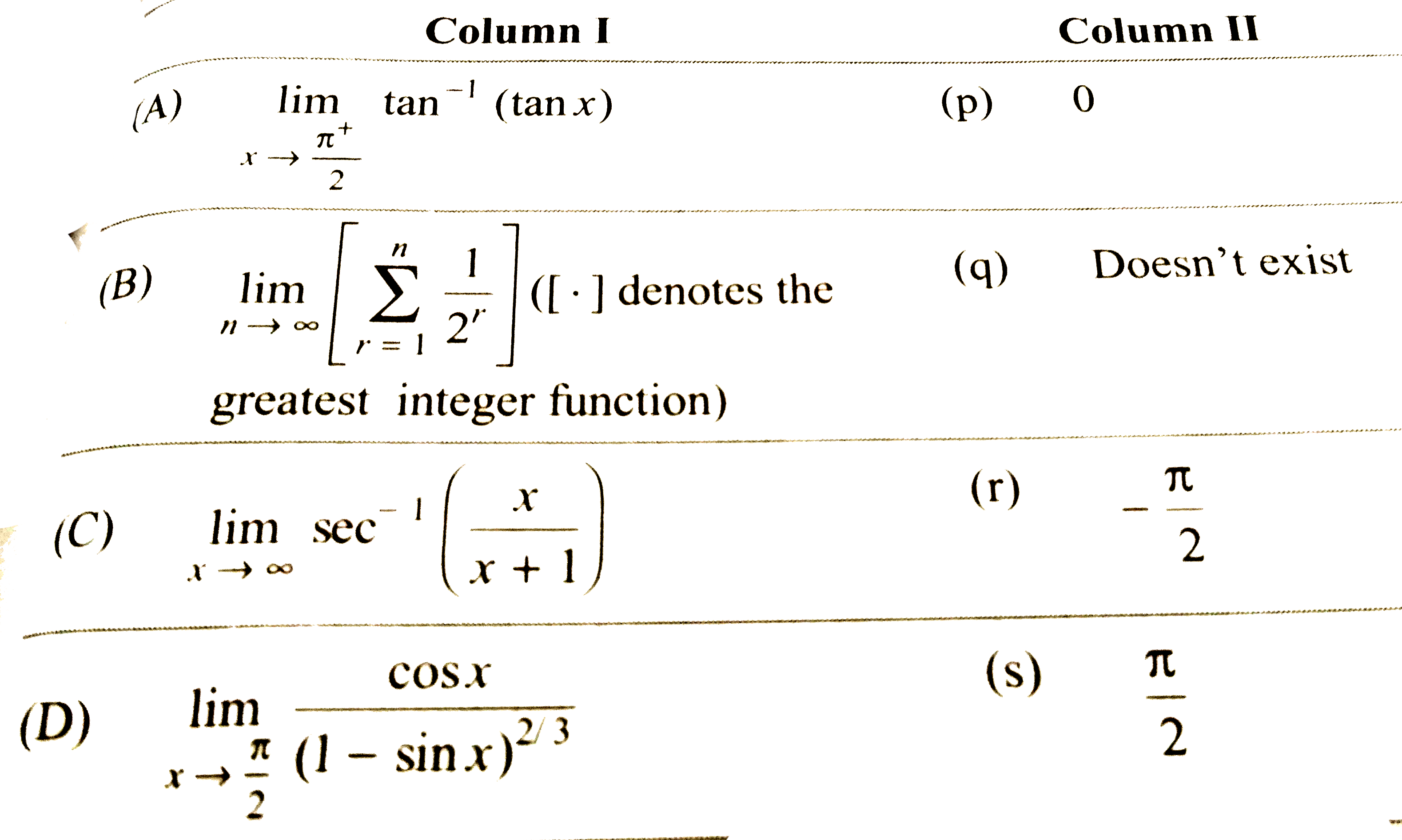Let f(x)=limn→∞(cos√xn)n,g(x)=limn→∞(1+x+xn√e)n
Now consider the function y=h(x) where h(x)=tan−1(g−1f−1(x)).
Range of the function y=h(x) is Solution in Punjabi
The correct Answer is:D
Step by step video & image solution for Let f(x)=lim_(ntooo)(cos sqrt(x/n))^(n),g(x)=lim_(nto oo)(1+x+x root(n)(e))^(n) Now consider the function y=h(x) where h(x)=tan^(-1)(g^(-1)f^(-1)(x)). Range of the function y=h(x) is by Maths experts to help you in doubts & scoring excellent marks in Class 12 exams.
Updated on:21/07/2023Topper's Solved these Questions
- LIMITSBOOK - ARIHANT MATHSCHAPTER - LIMITSEXERCISE - Exercise (Matching Type Questions)
3 Videos
- LIMITSBOOK - ARIHANT MATHSCHAPTER - LIMITSEXERCISE - MATCHING TYPE QUESTIONS
1 Videos
- LIMITSBOOK - ARIHANT MATHSCHAPTER - LIMITSEXERCISE - Exercise (More Than One Correct Option Type Questions)
15 Videos
- INVERSE TRIGONOMETRIC FUNCTIONSBOOK - ARIHANT MATHSCHAPTER - INVERSE TRIGONOMETRIC FUNCTIONSEXERCISE - Exercise (Questions Asked In Previous 13 Years Exam)
8 Videos
- LOGARITHM AND THEIR PROPERTIESBOOK - ARIHANT MATHSCHAPTER - LOGARITHM AND THEIR PROPERTIESEXERCISE - Exercise (Questions Asked In Previous 13 Years Exam)
4 Videos
Similar Questions
Match the statements of Column I with values of Column II.

View SolutionFind dydxif1−y=x
View SolutionIf limx→∞4x(π4−tan−1(x+1x+2))=y2+4y+5 then y can be equal to
View SolutionIf α=3sin−1(611andβ=3cos−1(49), where the inverse trigonometric functions take only the principal values, then the correct options (s) is (are)
View SolutionIn Which quadrant Point (−2,−3) will be lie.
View Solutionconsider two functions f(x)=lim_(x rarr oo)(cos((x)/(sqrt(n))))^(n) and g(x)=-x^(4b), where b=lim_(x rarr oo)(sqrt(x^(2)+x+1)-sqrt(x^(2)-1))
View SolutionLet f(x)=lim_(n rarr oo)(cos x)/((1+tan^(-1)x)^(n)), then int_(0)^(oo)f(x)dx=
View SolutionIf f(x)=lim_(n rarr oo)e^(tan((1)/(n))log((1)/(n))) and int(f(x))/(((sin^(11)x*cos x))^((1)/(3)))=g(x) then
View SolutionLet f(x)=cos((x)/(2))*cos((x)/(4))*...*cos((x)/(2^(n))). If lim_(n rarr oo)f(x)=g(x) and lim_(x rarr0)g(x)=k then value of lim_(y rarr k)[(1-y^(2011))/(1-y)]
View SolutionLetf:R→R be a real function. The function f is double differentiable. If there exists n∈N and p∈R such that limx→∞xnf(x)=p and there exists limx→∞xn+1f(x),then
limx→∞xn+1f'(x) is equal to
View SolutionLet f,g,h be differentiable functions of x. if Δ=∣∣ ∣ ∣∣fgh(xf)'(xg)'(xh)'(x2f)''(x2g)''(x2h)''∣∣ ∣ ∣∣and,Δ'=∣∣ ∣ ∣∣fghf'g'h'(xnf'')'(xng'')'(xnh'')'∣∣ ∣ ∣∣, then n =
View SolutionLet f(x)=limn→∞(cos√xn)n,g(x)=limn→∞(1+x+xn√e)n
Now consider the function y=h(x) where h(x)=tan−1(g−1f−1(x)).
limx→0In(f(x))In(g(x)) is equal to
View SolutionLet f(x)=limn→∞(cos√xn)n,g(x)=limn→∞(1+x+xn√e)n
Now consider the function y=h(x) where h(x)=tan−1(g−1f−1(x)).
Domain of the function y=h(x) is
View SolutionLet f(x)=limn→∞(cos√xn)n,g(x)=limn→∞(1+x+xn√e)n
Now consider the function y=h(x) where h(x)=tan−1(g−1f−1(x)).
Range of the function y=h(x) is
View SolutionLetf(x)andg(x) be two continuous function and h(x)=limn→∞x2n.f(x)+x2m.g(x)(x2n+1). if the limit of h(x) exists at x=1, then one root of f(x)-g(0) =0 is _____.
View SolutionIf f(x)=limn→∞xng(x)+h(x)xn+1 show that
f(x) =h(x), when 0<x<1
=12[h(x)+g(x)], when x=1
=g(x), when x>1
View Solution
